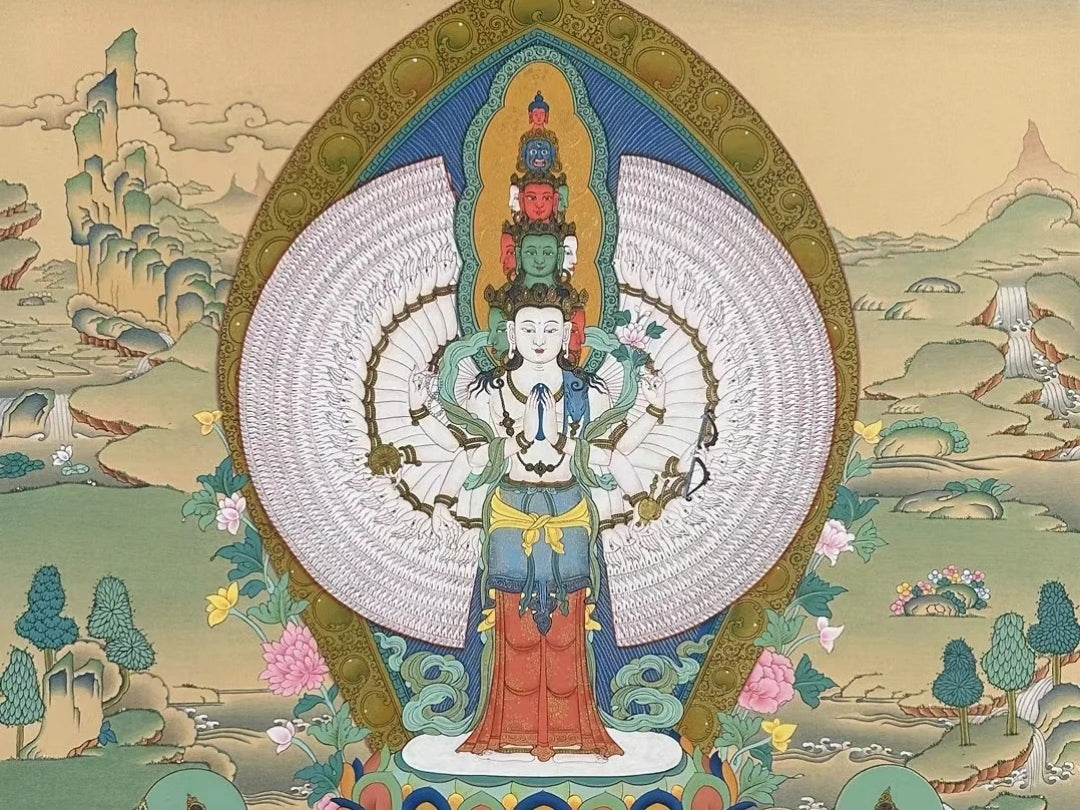Introduction to Padmasambhava and His Significance in Tibetan Buddhism
Padmasambhava, known as 莲花生大士 in Chinese, and as 贝玛迥乃 (Pema Jungne) in Tibetan, was a pivotal figure in Tibetan Buddhism. His name, Padmasambhava, meaning “Lotus-Born” in Sanskrit, symbolizes his enlightened qualities and his association with purity and wisdom. Born in ancient Uddiyana, present-day Swat Valley in northern Pakistan, Padmasambhava’s influence in the 8th century solidified the foundation for Tibetan Buddhism, spreading teachings that have since been immortalized through thangka ornaments, Buddhist jewelry, and spiritual art that continue to inspire devotees around the world.
The Life and Contributions of Padmasambhava
In the latter half of the 8th century, at the invitation of Tibetan King Trisong Detsen (赤松德赞), Padmasambhava brought Vajrayana Buddhism to Tibet. During this period, he used esoteric tantric practices to pacify local deities and spirits, aligning them with Buddhist principles. His methods helped make Tibet a land where Buddhism could flourish, uniting various spiritual practices and ensuring that they supported the teachings of Buddha. This movement was crowned by the founding of Samye Monastery (桑耶寺), Tibet's first official Buddhist temple, a hallmark that symbolized the establishment of Buddhism in Tibet.
Padmasambhava’s influence also extended to the development of exoteric and esoteric monastic institutions. Alongside eminent Indian scholars, he translated pivotal Buddhist texts into Tibetan and established the foundation for monastic communities. His role in building a strong Buddhist community allowed Tibetan Buddhism to thrive, reaching new levels of societal influence and spiritual depth.

Historical Context and Enduring Impact on Tibetan Culture
Padmasambhava’s teachings were essential in transforming the spiritual landscape of Tibet. Not only did he bring Buddhism, but he also forged a unique fusion between Tibetan Buddhism and the indigenous Bon tradition, creating a spiritual synthesis that resonated deeply with the local population. His work laid the groundwork for the Nyingma school (宁玛派), often referred to as the "Ancient School" or "Red School." As the Nyingma founder, Padmasambhava's esoteric teachings have had a profound influence on Tibetan Buddhism, with his methods and practices forming a core aspect of its spiritual heritage.
Beyond his impact on religious practices, Padmasambhava’s presence has left an enduring cultural legacy in Tibetan art and symbolism. Thangka paintings and Buddhist jewelry that feature his image or teachings continue to inspire practitioners, serving as constant reminders of his contributions to Tibetan spirituality.
Thangka Jewelry and the Influence of Padmasambhava’s Teachings
Padmasambhava’s profound teachings are often represented in thangka ornaments and Buddhist jewelry, which have become popular among followers and those interested in Tibetan culture. Thangka necklaces, in particular, serve as wearable representations of Padmasambhava’s teachings and legacy, symbolizing protection, compassion, and the pursuit of enlightenment.
These pieces are more than simple adornments—they encapsulate centuries of Tibetan tradition and spirituality. By wearing thangka jewelry, individuals carry a piece of this heritage with them, experiencing a tangible connection to the teachings of Tibetan Buddhism.

The Broader Influence of Padmasambhava’s Legacy
Today, the influence of Padmasambhava extends beyond Tibet. His teachings have reached followers and enthusiasts worldwide, influencing the spread of Tibetan Buddhism in regions such as Nepal, Bhutan, and India, as well as in Western countries. Buddhist jewelry and thangka art have become not only spiritual symbols but also cultural emblems cherished by practitioners and art enthusiasts alike.
Padmasambhava’s arrival in Tibet and his profound contributions have left an indelible mark on Tibetan Buddhism, establishing practices that continue to flourish. His teachings, encapsulated in the artistry of thangka jewelry and Buddhist ornaments, carry forward the wisdom of Tibetan Buddhism, inviting a new generation of followers to explore the spiritual path he pioneered. Through these representations, his legacy endures as a cornerstone of Tibetan culture and spirituality.



